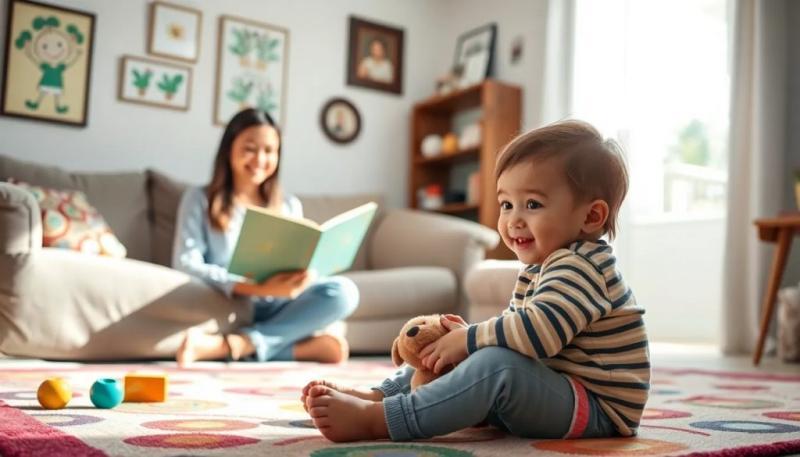Preparing your child for their first babysitter can be a crucial step in ensuring a smooth transition for both kids and parents. The right preparation can not only reduce anxiety but also create a welcoming environment for the babysitter. In this guide, we will explore effective strategies on how to prepare kids for their first babysitter and ensure everyone feels comfortable and secure.
Preparing your toddler and preschooler for a babysitter
The first thing to consider is how to introduce the babysitter to your child. Having a meet-and-greet session can be very effective. This allows your child to see the babysitter in a friendly environment and get to know them a little. You can also explain who the babysitter is and what they will be doing together.
Involve your child in the process of selecting the babysitter by talking about their interests or asking them what they would like to do together. This helps in building a sense of control and excitement around the new arrangement.
It's beneficial to set clear rules and expectations before the babysitter arrives. Explain to your child what they can and cannot do while the babysitter is present. This not only provides structure but also reassures them that their safety is your top priority.
- Discuss the schedule: Talk about what your child can expect in terms of timing and activities.
- Emphasize safety: Reinforce that the babysitter is there to take care of them and keep them safe.
- Practice scenarios: Role-playing can be a fun way to prepare your child for interactions with the babysitter.
Effective ways to introduce kids to a babysitter
Introducing your child to a babysitter should be done in a positive and engaging manner. Start with a casual introduction, perhaps during snack time or while playing a game. This can ease the tension and allow your child to see the babysitter as a fun companion.
Encourage your child to ask questions about the babysitter's interests or experiences with kids. This builds rapport and makes the babysitter feel more like a friend rather than a stranger.
Having a small gift or activity planned can also help break the ice. You might choose a simple craft project or a fun game that the babysitter can facilitate. This not only fosters interaction but also creates a fun atmosphere.
Tips for easing children's anxiety about babysitters
Children often feel anxious about new experiences. To help ease their anxiety about a babysitter, start by validating their feelings. Let them know that it's completely normal to feel a bit nervous.
Share positive stories about babysitters or fun experiences with caregivers to demonstrate that it can be a great time. Highlight the fun activities they will do together, such as playing games or reading books.
- Reassure your child: Consistently remind them that they are safe and loved.
- Prepare a comfort item: Allow your child to keep a favorite toy or blanket with them during the babysitting.
- Use a timer: Explain that the babysitter will be there for a certain amount of time and then you will return.
Engaging in calming activities, such as reading a story about babysitters or having a calming pre-babysitting routine, can also help your child adjust to the new experience.
How to make a babysitter feel welcome
Making the babysitter feel welcome sets the tone for a successful experience. A warm introduction can go a long way, so be sure to introduce them to your child in a friendly manner.
Provide the babysitter with important information about your child, including their likes, dislikes, and any routines they follow. This not only helps the babysitter but also shows them that you value their role.
Consider preparing a small welcome package for the babysitter, which could include snacks, a list of emergency contacts, and a brief overview of your child’s daily routine. This gesture not only makes them feel appreciated but also provides them with the tools they need for a successful babysitting experience.
Best activities for kids with a new babysitter
Planning activities is a great way to keep kids engaged while the babysitter is in charge. Here are some wonderful ideas to consider:
- Art projects: Set up a mini art station with crayons, markers, and paper.
- Outdoor play: Encourage outdoor activities like playing ball or going for a walk.
- Interactive games: Games like "Simon Says" or simple board games can be entertaining and educational.
Involving kids in the planning process can also yield great results. Ask them what activities they would enjoy doing with the babysitter. This not only empowers them but also fosters a greater bond between your child and the babysitter.
Lastly, ensure that the activities align with your child's interests and comfort levels. Tailoring the activities based on your child’s preferences will make the experience more enjoyable for everyone.
Preparing toddlers for new babysitters
When preparing toddlers for new babysitters, it’s important to create a sense of familiarity. You can start by reading books about babysitters or watching children’s shows that feature babysitting scenarios. This can help normalize the experience.
Reinforcing positive behavior is crucial. Praise your child for being brave and expressing their feelings about the babysitter. Positive reinforcement can significantly boost their confidence.
Finally, planning a transition period where the babysitter comes while you are still home can make the adjustment easier. This allows your child to see the babysitter in a low-pressure environment and gradually get used to their presence.
Questions related to preparing for babysitters
Frequently asked questions about babysitting preparation
What to prep for a babysitter?
Preparing for a babysitter involves several key steps. Start by discussing your child’s routine and preferences with the babysitter. Provide information about any special needs, allergies, or emergency contacts. Additionally, ensure that the environment is safe and welcoming, with activities planned to keep your child engaged.
What age should a child start babysitting?
Typically, children can start babysitting for younger siblings around the age of 12, but this can vary based on maturity and responsibility. Teaching them basic caregiving skills through supervised experiences can help them prepare for this role.
How to prepare for your first babysitting job?
For first-time babysitters, it's essential to understand the child's routine and preferences. Familiarizing yourself with emergency procedures and understanding how to handle common situations can also be beneficial. Practicing patience and being open to communication with the child can make the experience smoother.
Is $10 an hour good for babysitting?
The average rate for babysitting can vary by location and experience. $10 an hour may be considered a reasonable starting point, but rates can increase based on the number of kids, special needs, or added responsibilities. Researching local rates can provide better insight into what is fair.
En este sentido, te invitamos a ver un video que ofrece consejos útiles sobre cómo preparar a los niños para su primera experiencia con un canguro.



